Asphalt Maintenance: 5 Critical Steps and a Durable Alternative
Asphalt is the single most common paving material used across the world. It’s a relatively cheap material and although not eco-friendly, it is somewhat durable and effective as a paving material. One of the biggest defining characteristics of asphalt, though, is the amount of maintenance that it requires.
Asphalt maintenance is an extensive and painstaking process with a handful of steps involved. In case you’re in charge of maintaining asphalt, let’s take a look at some of the crucial steps involved and what a better, more durable alternative may be.
Maintaining Asphalt Pavement
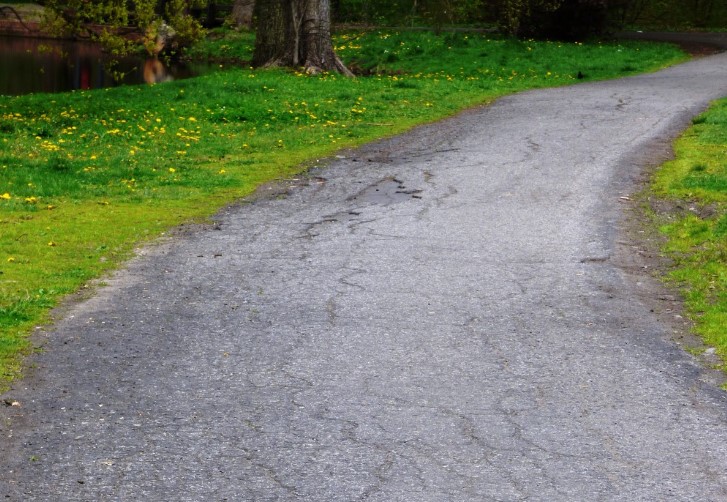
1. Painting Lot Lines
Asphalt maintenance consists of a few different things. The most basic maintenance you’ll have to perform is the repainting of lot lines. The yellow, white, and/or other-colored lines are used to mark parking spots and other things on asphalt.
2. Sweeping
Sweeping is another type of maintenance that is typically performed before more extensive repairs are about to take place. You might also spray down asphalt pavement with a hose to remove dirt.
3. Repairing Potholes and Cracks
Repairing cracks and potholes is a type of minor maintenance that you may need to perform on asphalt pavement. This involves filling the cracks and/or potholes with fresh asphalt and letting it dry so that there are no open gaps in the surface of your asphalt pavement.
Once damage has already occurred to your asphalt pavement, the only choice is to repair the damage with minor repairs like filling cracks and gaps.
4. Sealcoating
One of the most important parts of asphalt maintenance is using a seal coat on the surface. This is so that water never has the chance to penetrate it to begin with and cause these minor damages.
Sealcoating generally needs to be done once every 3-5 years or so and is a rather quick process. The asphalt is swept and cleaned first, before one or more coats of sealant are applied to the surface of the pavement and allowed to dry.
This sealant provides a barrier between the surface of the asphalt pavement and any water that might penetrate it. Once the seal coating wears off, the asphalt surface is vulnerable to moisture intrusion.
5. Resurfacing
Resurfacing is the most extensive type of asphalt repair and generally involves the same process as repairing cracks and potholes, except it’s done on the entire surface of the asphalt.
Resurfacing is done when damage done to the asphalt surface has been very extensive, or you’ve gone 10 years without resurfacing. It’s recommended that you resurface asphalt about once every decade or so. After resurfacing, you’ll need to add more sealant and more lot lines as well.
The Disadvantages of Asphalt
The disadvantages of asphalt are many. It’s not very eco-friendly, for starters. It’s also impermeable in most cases. This means that you need to include expensive drainage systems for parking lots and asphalt driveways won’t be effective at draining stormwater.
Asphalt also gets sticky in hot temperatures and is not as durable as a material like permeable plastic pavement, for example. Asphalt breaks down rather quickly, especially with regular use. Asphalt driveway maintenance can be costly and time-consuming as well.
A Superior Alternative to Asphalt Pavement

If you’re wondering about a better alternative to asphalt paving and maintenance, you don’t need to look any further than permeable plastic pavers from TRUEGRID. Unlike asphalt, TRUEGRID pavers require almost zero maintenance throughout their entire lifetime (up to 60 years). They suffer virtually no damage from the typical factors like traffic, wind, rain, UV exposure, tree roots, and anything else you can think of.
In fact, both TRUEGRID PRO LITE and TRUEGRID PRO LITE PLUS are strong enough to handle the weight of a monster truck driving off a ramp and landing on them without breaking, and that’s before they’ve even been filled with gravel.
Permeable pavers are used to trap gravel and lock it into place over a 6 inch – 8 inch sub-base of gravel, and create a paved surface that is 100% permeable and capable of handling even the heaviest of rainstorms.
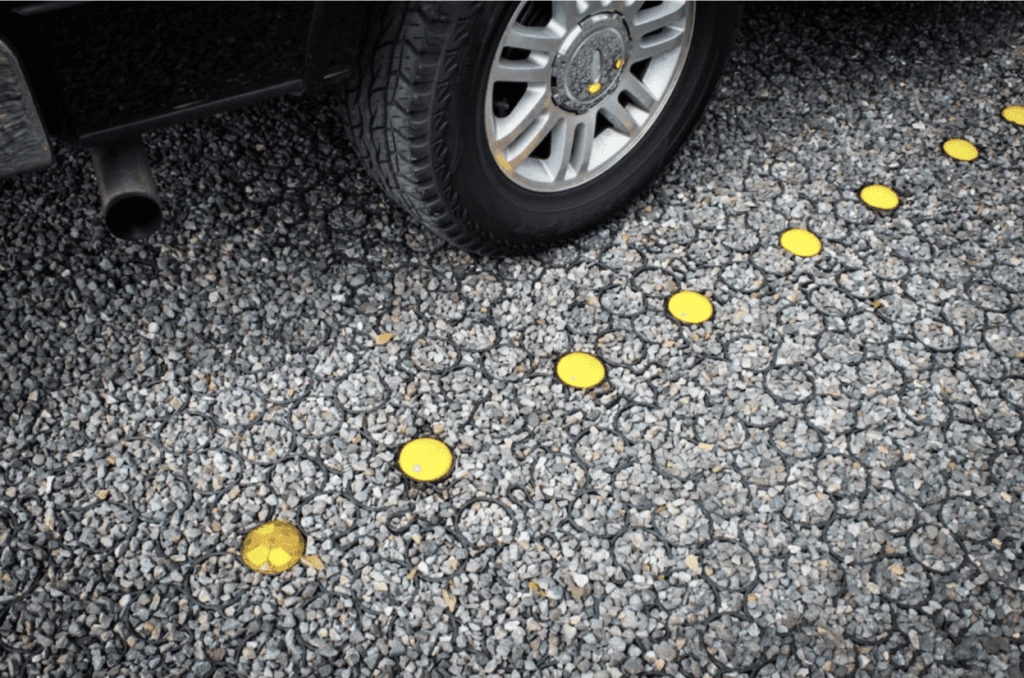
The installation process is incredibly quick and can usually be completed in a day or less, depending on the scope of the project. The advanced level of permeability means that you can do away with most other forms of stormwater drainage, to save both time and money in the process.
TRUEGRID pavers are made from 100%-recycled plastic, which makes them one of the most eco-friendly paving products on the planet. They use very little heavy equipment during installation and have a low carbon footprint compared to other materials like asphalt and concrete.
Let TRUEGRID Solve Your Asphalt Maintenance Concerns
Asphalt maintenance is costly, time-consuming, and not very environmentally-friendly. If you want a superior paving option to asphalt that’s durable, 100%-permeable, eco-friendly, sturdy, and aesthetically pleasing, give TRUEGRID a call today to contact a pavement professional who can help you get started.
A green stormwater infrastructure design is one that incorporates a variety of different elements in order to facilitate the most eco-friendly flow of stormwater possible. Modern-day stormwater infrastructure is often anything but eco-friendly.
Therefore, the need for green stormwater infrastructure has increased. A green stormwater infrastructure design includes multiple elements all intended to maximize the eco-friendliness of the way in which stormwater is dealt with and diverted back into the ground.
There are plenty of unique elements in such a design, so in case you’re interested in building a design like this of your own, let’s discuss the 8 features of a successful green stormwater infrastructure design:
1. Disconnected Downspouts
Many downspouts in urban areas divert water directly into a sewer system. This often creates a strain on the local sewer system and degrades the quality of the water as it picks up pollutants on its way through the streets. By disconnecting your downspouts and letting water flow directly from your gutters into the ground below, you can divert stormwater directly back into the ground where it belongs.
Creating a permeable surface such as a small gravel pit directly beneath your gutters, you can send stormwater right back into the ground and lessen the burden on your local sewer system and water management system.
2. Harvesting Rainwater
By harvesting rainwater, you lessen the burden on the local sewer system and capture freshwater for later use. The water can be used to nurture pets and wildlife, as well as help water lawns and gardens. Rain barrels, aquifers, ground-level pits, cisterns, and even nets to capture dew and fog are all common methods used for collecting rainwater.
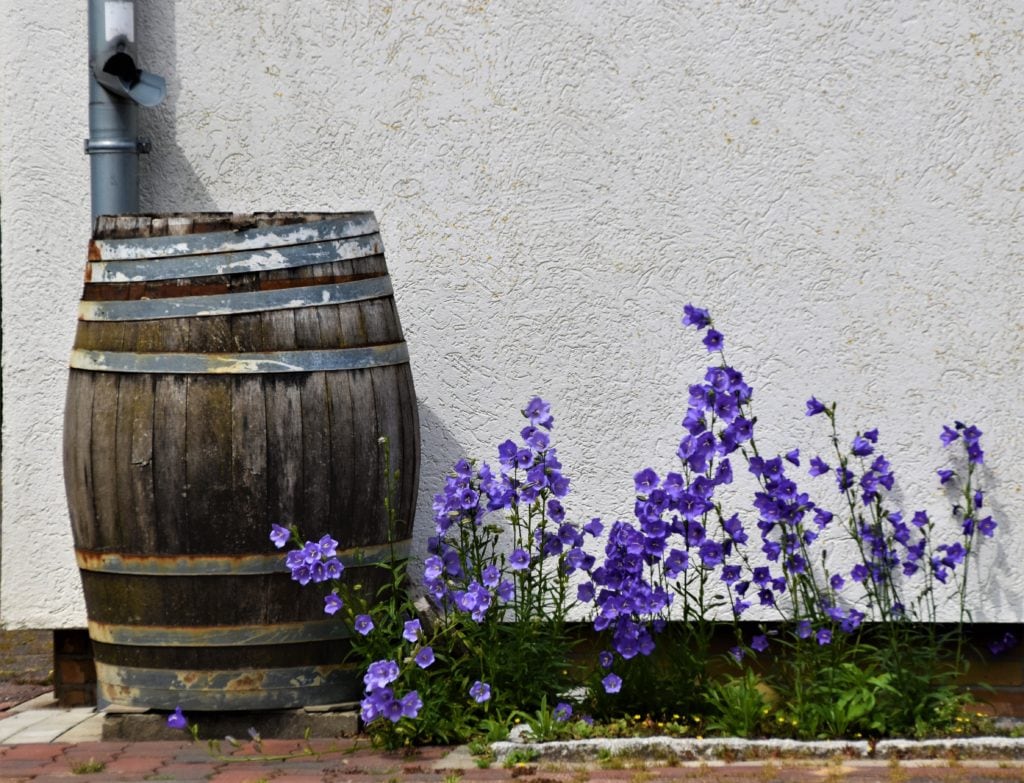
3. Planter Boxes
Mostly found in urban areas, planter boxes feature trees and/or plants and are used to help collect rainwater to lessen the amount that’s flowing on the streets and into the sewers. They’re most useful for areas that have limited space and can add a nice aesthetic element to any area.
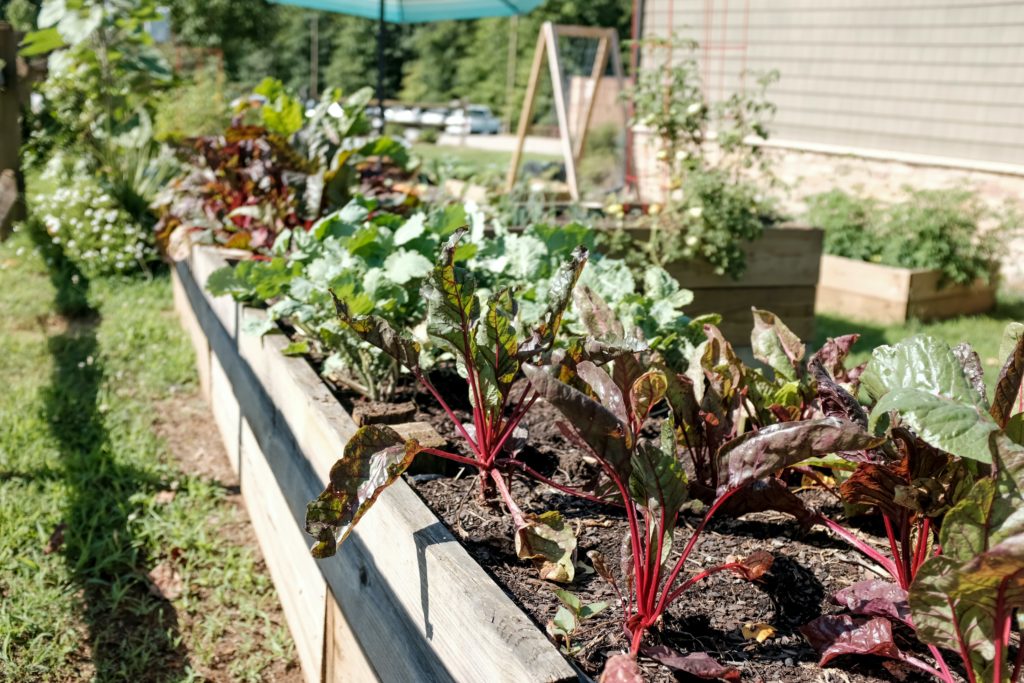
4. Bioswales
Bioswales are most often found near curbs and in parking lots. They use a lot of thick, short vegetation to help filter stormwater and slow down the flow as it makes its way into the sewers.
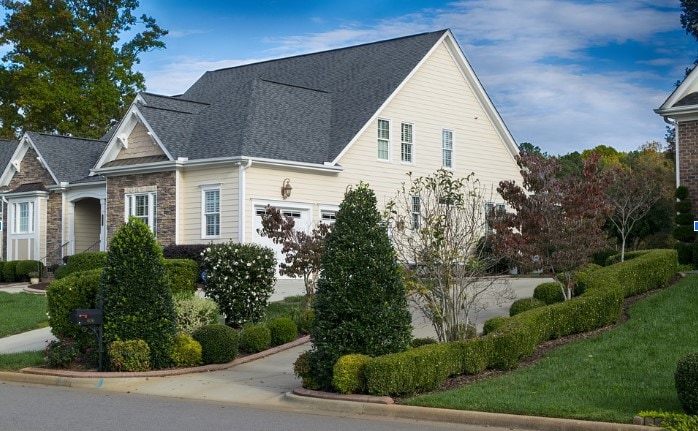
5. Green Roofing
Green roofs utilize plants and shrubs specifically to facilitate the infiltration of rainfall and allow for it to naturally evaporate as opposed to being directed into sewers. Green roofing is especially useful in urban areas where land and space are at a premium. Often the only place to put such a green area is the unused space on the roof, so green roofing is one of the most efficient types of green stormwater infrastructure.
Roofing services play a critical role in ensuring that a structure is durable, weather-resistant, and energy-efficient. A professional roofing company will assess the unique needs of each building, taking into account factors such as climate, architecture, and local regulations. Their expertise ensures that the roof is not only functional but also offers longevity and protection from the elements. Whether it’s a commercial or residential property, choosing the right roofing service provider can make a significant difference in the quality and lifespan of the roof.
For those looking to install or replace a roof, selecting an experienced team is essential. The Las Vegas Roofing Company specializes in providing high-quality, reliable roofing solutions tailored to the specific needs of their clients. They offer a range of roofing options, from traditional materials like shingles to more modern choices like metal and tile roofing. By using industry-leading techniques and materials, they ensure a solid and lasting roof that can withstand the harsh weather conditions common in urban environments.
Experienced roofing contractors understand that timely assessments can prevent minor damage from turning into major problems, especially in areas prone to severe weather. An expert team will thoroughly evaluate every aspect of your roof—from shingles and flashing to gutters and drainage systems—identifying weaknesses and recommending appropriate solutions.
In addition to new installations and replacements, regular inspections and prompt emergency repairs are vital to maintaining the integrity of any roofing system. The Akron Roofing Company understands the urgency that comes with unexpected roof damage caused by storms, heavy winds, or other unforeseen events, and they provide swift, dependable emergency solutions to prevent further deterioration. Their skilled contractors conduct thorough inspections to identify potential vulnerabilities early on, offering preventative maintenance that can save property owners from costly repairs down the line.
6. Tree Canopies
Using trees as a way to absorb water is another popular answer to the question of what is green stormwater infrastructure. Trees not only absorb water in their leaves and branches, but also directly through their roots as well. In this way, trees help to slow, filter, and mitigate the flow of stormwater into sewers, while simultaneously providing shade and a calming effect on traffic.
7. Land Conservatories
Parks and other swaths of land that are almost wholly undisturbed by humans are the perfect bioswales. They provide all the benefits as many of the things described above, but to a much larger degree. A single park in the middle of a town can act as a quasi-storm drain and water filtration system all by itself.
8. Permeable Pavement
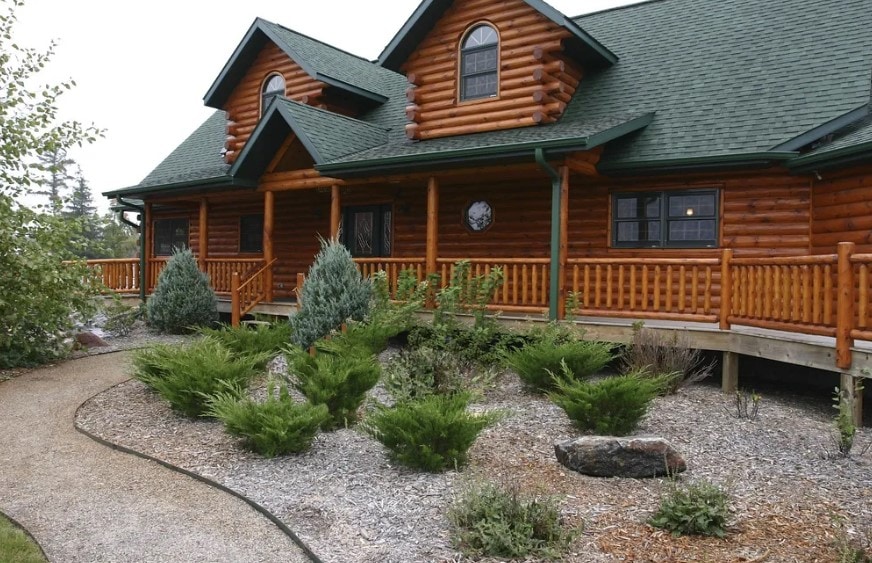
Permeable pavement is one of the most useful ways to create stormwater green infrastructure. Permeable parking lots, sidewalks, fire lanes, and pathways all help to facilitate stormwater drainage while also providing a paving option that can be used by humans.
Permeable pavement works by allowing water to drain directly through itself and into the soil below. It can be used to replace many other stormwater drainage systems considered to not be eco-friendly. It can also be used as a supplement in conjunction with the other items on this list.
Permeable pavers such as the kind made by TRUEGRID, for instance, are 100% permeable and can handle very heavy flows of stormwater without flooding.
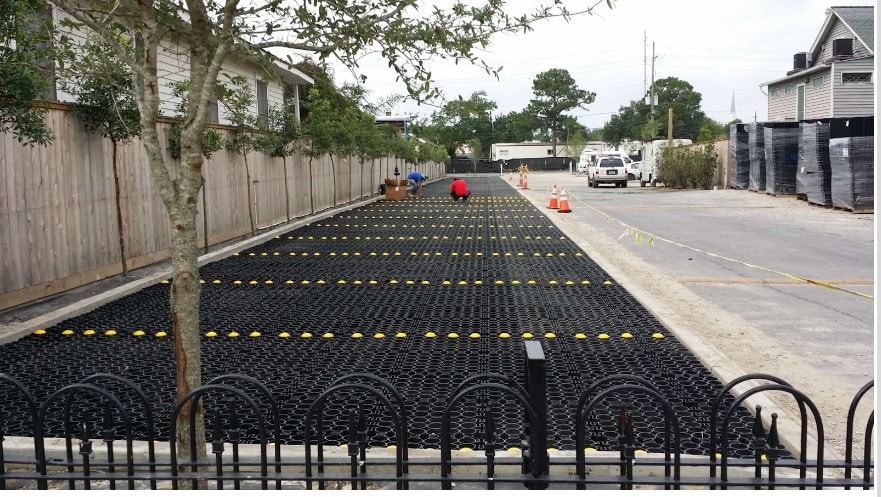
Implementing something like a permeable parking lot built from either TRUEGRID PRO LITE or TRUEGRID PRO PLUS pavers is one of the best ways to mitigate the need for additional stormwater drainage as well as contribute to the overall effectiveness of green stormwater infrastructure.
Plastic pavers will trap gravel and create a durable, level paved surface, and you can also help filter out any trash and/or debris that may have ended up in the sewers if you were using a regular asphalt or concrete parking lot.
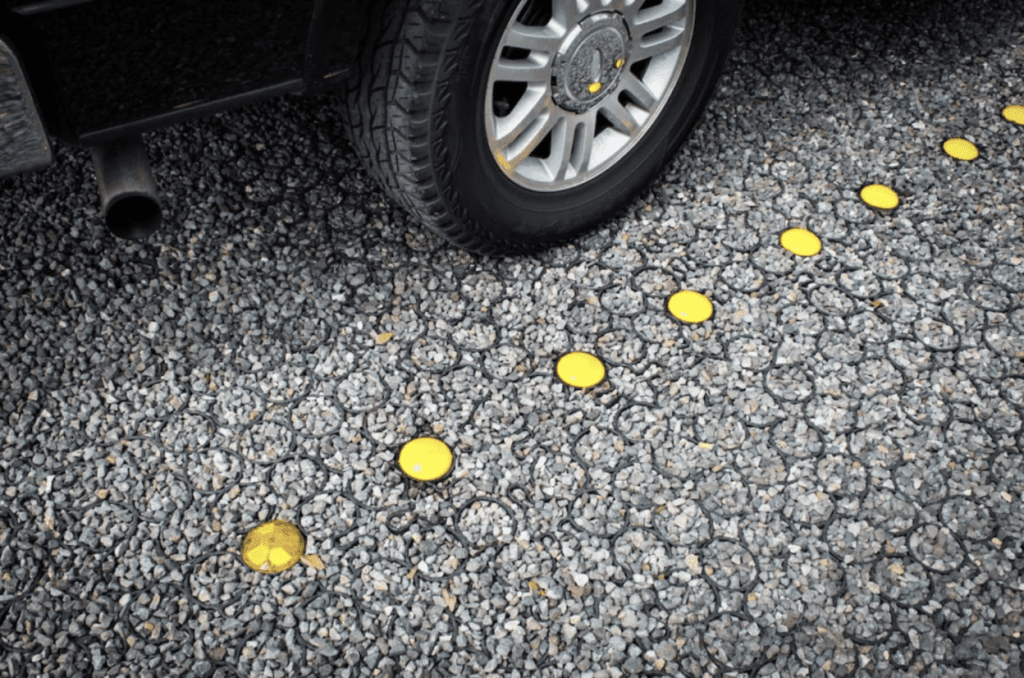
TRUEGRID Pavers Are a Valuable Part of Any Green Infrastructure Plan
If you want the perfect addition to your green stormwater infrastructure design, TRUEGRID pavers are an excellent choice. Not only do they divert stormwater into the soil instead of the sewers, they can also help filter the water and will last up to 60 years with only minimal maintenance required. If you’re looking for a high-value addition to your stormwater infrastructure design, contact TRUEGRID today to get in touch with a pavement professional for a free quote.
Stormwater drainage is a big deal for many homeowners and business owners everywhere. Stormwater needs to have one or more outlets for drainage when storms occur or else the water will pool, flood, and cause a variety of issues that nobody wants to deal with.
Stormwater Drainage Systems
Thankfully, there are a wide variety of stormwater drainage design examples, with some being more effective than others. In case you’re about to implement a stormwater solution on your property or you’re looking for a better alternative to what you currently have, here are 7 types of stormwater drainage systems:
1. Slot Drains
Slot drains are a recent innovation in drainage technology. They utilize long, thin drain slots that often run the entire length of a room or area. They are great for outdoor areas that don’t require excessive drainage, however they tend to flood easily when exposed to heavy rainfall.
This issue makes slot drains one of the least effective stormwater drainage design examples. Even with multiple slot drains installed, outdoor areas are very hard to manage with this type of drain, because water quickly overflows them.
They can work effectively in light rainstorms and situations where the rate of precipitation isn’t very high. They can also be driven and walked on without issue, and are rather easy to clean when compared to other types of drains.
2. Open Storm Drains
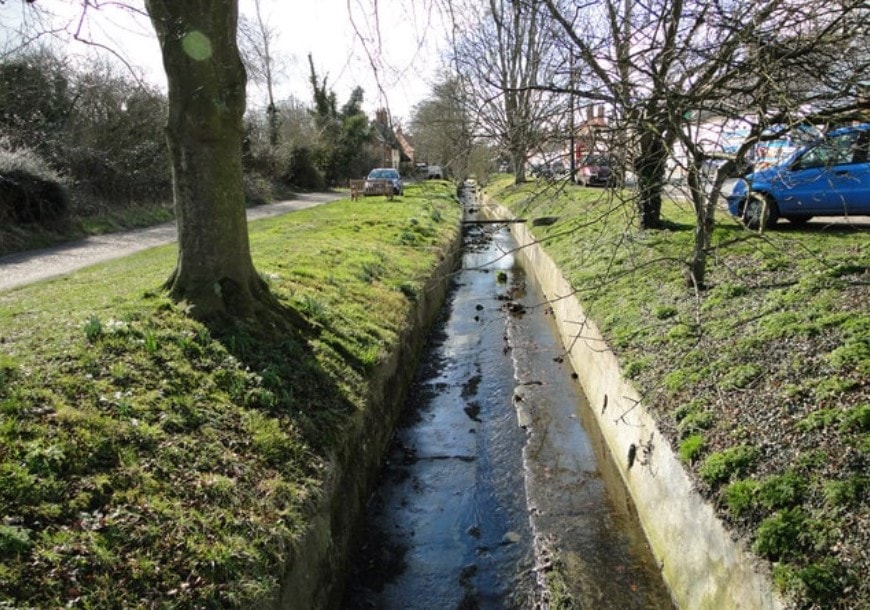
Open storm drains are drains that usually run parallel to a nearby road or to the edge of a property. They feature long, uncovered channels to carry free-flowing stormwater. These channels often direct water into a local sewer system where the water can be treated and managed. Open storm drains can be expensive to set up but are usually cheap to maintain once they’ve been installed.
They are a great stormwater drainage design for those who aren’t too incredibly concerned about looks, and want to collect surface water with ease. Lots and paved areas can be sloped towards open storm drains. They are unsafe, though, and require fencing to keep animals and people from falling in. They can also smell and may even decrease your property value.
3. Closed Storm Drain
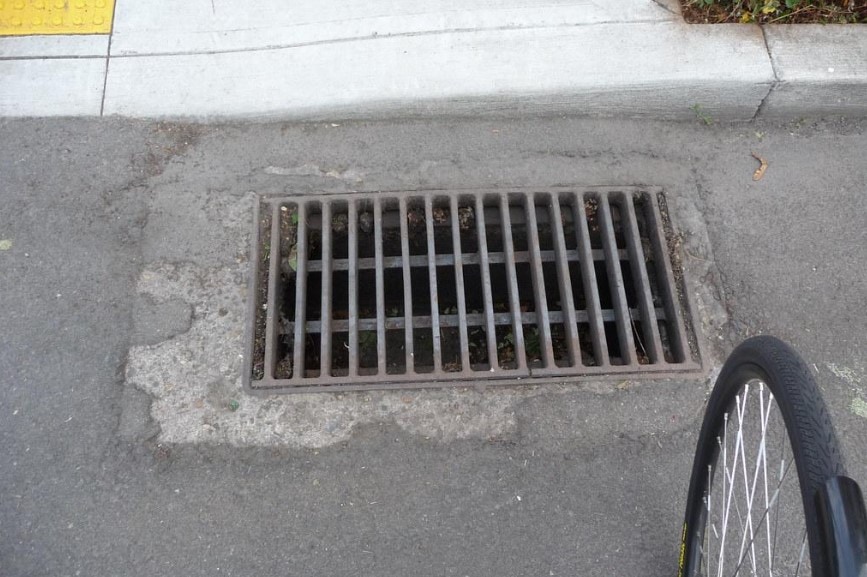
Most of the stormwater management systems you see now are stormwater grates that lead to a local, underground sewer system. Closed storm drain grates can be found in the low areas of parking lots, the trenches near sidewalks, and other areas where water intentionally or unintentionally tends to collect. Though safer and less unsightly than open storm drains, they are difficult to clean and labor-intensive to install.
4. French Drain
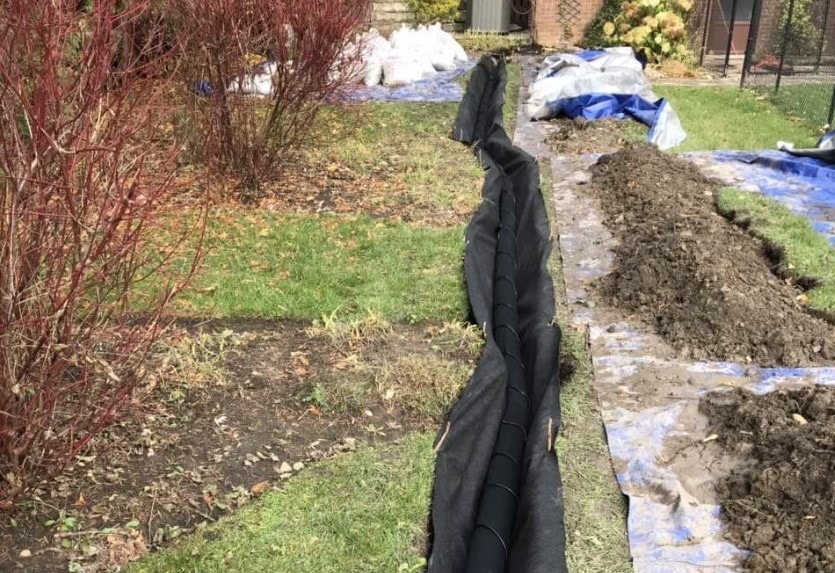
If you want to prevent water from pooling around the foundation of your home or building, French drains are the answer. French drains typically utilize small grates located near the foundation of a building. The grates funnel the water into long pipes that carry it away from the edge of the building and into the street, or even into a water retention basin.
The best part about French drains is that the long pipes they use are almost always covered up with an aesthetically pleasing material, such as pebbles or grass. They also make use of intricate, beautiful grates as well. French drains are great for draining water that pools near the foundation of a building, but are not as effective when it comes to draining surface water over a broader area.
5. Permeable Pavement

Permeable pavement might sound like more of a paving solution than a stormwater drainage solution, but it’s actually both. TRUEGRID PRO LITE and TRUEGRID PRO PLUS are both 100%-permeable and capable of effectively draining water from even the most intense rainstorms.
Permeable pavement can be utilized as a replacement for regular asphalt and concrete, which makes your entire parking lot or paved area into one big storm drain. The water filters through the gravel trapped in the pavers and drains back into the ground where it belongs. A parking lot made from these pavers also looks incredibly clean and professional.
TRUEGRID permeable pavers require almost no maintenance over a 60-year lifespan and are the quickest to install among all the drainage systems. They are also incredibly durable and can handle constant, heavy traffic without failing.
6. Slope Drains
Slope drains make use of the natural incline of the ground around a home or business. The pipes used in slope drains are made from either steel, concrete, or plastic. They run downhill and are usually covered with some sort of grate in order to protect people and animals from falling in.
7. Gutters and Downspouts
A gutter and downspout system is the most common type of drain for both homes and businesses. Gutters are installed around the roof of the building and the water that drains into them is directed downwards into downspouts. The downspouts are usually near a slope so that the water can naturally flow away from the foundation of the building and not pool at the base. Downspouts are typically either square or round in shape and are made from copper, aluminum, or steel.
It’s Time to Embrace a Better Stormwater Drainage Solution
TRUEGRID has created one of the most effective, durable, affordable, eco-friendly, and aesthetically pleasing stormwater drainage solutions available, which is why many homeowners and business owners are switching over to TRUEGRID permeable pavement.
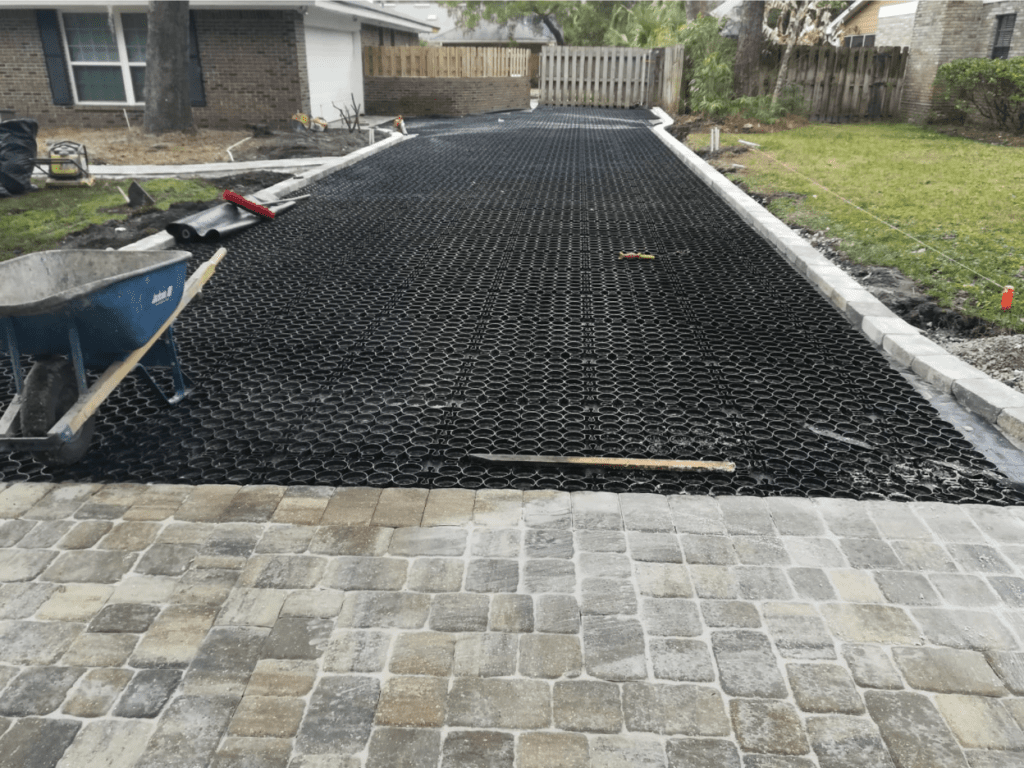
If you need a way to drain stormwater that won’t take weeks to install, won’t require costly maintenance, and won’t require you to sacrifice one inch of surface area for drainage equipment, call TRUEGRID today for a quote.
Are you looking for a new type of driveway besides the standard asphalt or concrete driveway that most people have? There are plenty of benefits to choosing an alternative driveway and a plethora of options to choose from as well. Asphalt and concrete have been commonplace for a long time but alternative driveways are gaining popularity for many reasons.
For example, grass strip driveways are now extremely common in dry areas that don’t get much rain, like L.A. If you’re interested in building a grass strip driveway, let’s take a look at what the best practices are and how this type of driveway can benefit you.
Benefits of a Grass Strip Driveway
There are many benefits to using a concrete driveway with grass strips as opposed to a regular asphalt or concrete one. The first is that it just looks better. Asphalt and concrete are uniform in color, typically. You have one, solid driveway that blends in with all the homes around you.
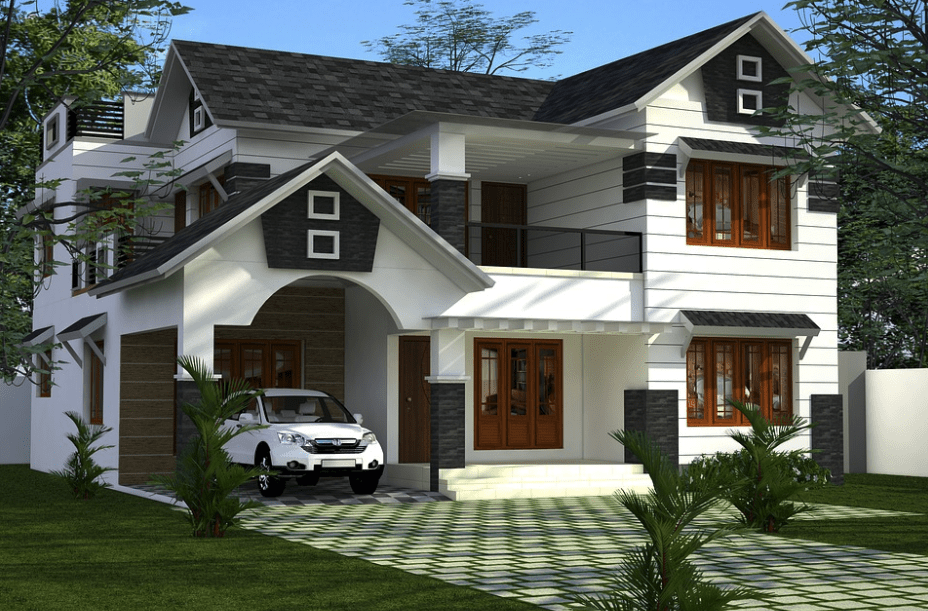
Driveway strips with grass are nice because they include greenery within the design of the driveway itself. This is a curious and eye-catching design in the eyes of most people and can appear very elegant if installed properly. The blend of green grass and concrete or even gravel-filled pavers is enticing to many, and can certainly drive up your home value in the right neighborhood.
Another benefit of using a driveway with grass strips is that it’s permeable. Water from storms is able to drain into the cracks between the pavement and into the soil below. This prevents runoff and erosion and will lengthen the lifespan of your grass strip driveway beyond that of a typical concrete driveway. Though, you’ll still have to reseal and resurface the concrete slabs every so often, standing water won’t be as much of a problem.
How to Build a Grass Strip Driveway
Building a driveway with grass strips can be done in a variety of ways. One of the most common approaches is by incorporating grass strips with artificial grass installation around the edges of concrete slabs. To achieve this, the installation process for this type of driveway is rather simple, though it can take a while to complete due to the drying process involved with concrete.
First, your existing driveway would need to be removed and excavated before proceeding. If you are starting from scratch, however, you simply need to pour the concrete slabs where you need them and let them dry.
The spaces in between would be filled with either artificial turf or soil and real grass. In this context, choosing artificial turf is highly recommended, as it is more durable and easier to maintain than regular grass. An experienced artificial grass suppliers can provide quality turf options for an aesthetically pleasing and low-maintenance grass strip driveway. However, normal grass could also suffice if desired.
A Better Alternative to a Grass Strip Driveway
Concrete is just one type of material you can build a grass strip driveway with, but there are other, even better alternatives. Permeable plastic pavers are one example of a material that can be used to create grass strip driveways with an even higher level of permeability, durability, and eco-friendliness.
Look at the permeable pavers made by TRUEGRID, for example. The TRUEGRID PRO LITE and TRUEGRID PRO PLUS pavers are both made from 100%-recycled plastic and will last up to 60 years before needing replacement. In terms of maintenance, they require next to none in comparison to concrete grass strip driveways. They’re also 100% permeable.

Durability is a huge benefit of using permeable plastic pavers in favor of concrete. The plastic pavers trap gravel in place to create a driving surface that never deteriorates or requires repairs in the way that concrete does.
A TRUEGRID permeable paver grass strip driveway looks great as well and you don’t have to sacrifice any style points when opting for pavers over concrete, either. A professionally installed grass strip driveway made from TRUEGRID pavers looks clean-cut, professional, and beautiful.
Installing a Grass Strip Driveway with Plastic Pavers
The installation process for a TRUEGRID grass strip paver driveway is simple and quick. First, each driving area must be excavated to a depth of about 10 inches, at which point a piece of fabric is laid for separation between soil and base aggregate.
8” of base aggregate is then spread and compacted.
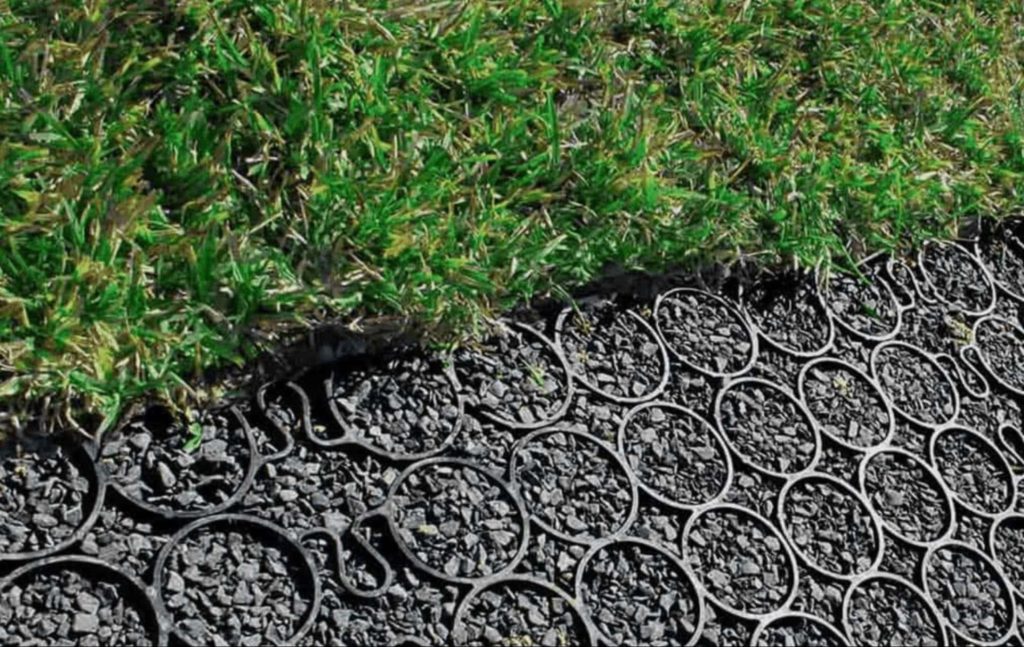
Next, the TRUEGRID is simply laid over the base aggregate…connected and filled with soil. Hydro-seed is then spread over the soil filled TRUEGRID. Once the grass has established the driveway is ready to go!
TRUEGRID Makes the Best Pavers for Driveways with Grass Strips
If you want a driveway that will boost curb appeal, eliminate maintenance concerns almost completely, and is about as eco-friendly as can be, make sure to get in touch with a pavement professional at TRUEGRID today who can get you pointed in the right direction.

